Rajeev Anantaram
India is all set to unfurl its ambitious New Manufacturing Policy, a 15-year vision document that seeks to raise the share of manufacturing to 25 per cent of GDP by 2025, creating 100 million new jobs in the process.
The policy's goals are laudable. India needs to rapidly generate gainful employment for the millions of young men and women expected to join the work force in the coming decade.
An inability to do so would soon result in the vaunted demographic 'dividend' morphing into a demographic 'curse', with unimaginable social and political consequences.
The NMP seeks to replicate China's experience in emerging as a manufacturing hub, with forward and backward links to global supply chains.
. . .
Why India must not ape China's manufacturing policy
Photographs: Reuters
This is reflected in some of the policy initiatives proposed in the plan, such as fiscal support for indigenous technology, labour policy reforms (to allow for flexible labour contracts), among others.
It is in the establishment of National Industrial and Manufacturing Zones that India is attempting to emulate what is arguably the most visible policy initiative undertaken in China to boost manufacturing.
First, a few facts. The Chinese economy has grown at an average annual rate of 9 per cent between 1985 and 2010. It is the sheer duration for which this expansion has been sustained rather than the sheer growth numbers themselves that is awe inspiring.
China's growth was founded on a labour-intensive, mass manufacturing revolution driven by foreign direct investment, predominantly by non-resident Chinese based in Hong Kong and Taiwan.
. . .
Why India must not ape China's manufacturing policy
Photographs: Reuters
The literature analysing China's success in becoming the world's manufacturing hub identifies several factors starting with sweeping reforms in the agriculture sector in 1980, that included partial privatisation of collectives through the 'Household Responsibility' System (which leased land to individual farmers) and the 'Dual Pricing' system, whereby the state claimed a fraction of their produce at pre-determined prices, while allowing the remainder to be sold at market prices.
These reforms led to a productivity surge, which boosted rural incomes, enhanced food security and, more importantly, allowed for a reallocation of surplus labour from agriculture to industry, especially to the Township and Village Enterprises (TVE), which became the engine of manufacturing-led growth in China for almost two decades thereafter.
Other important determinants -- government procurement policies that provided the initial demand, tax reforms that allowed local governments to retain the dominant share of tax revenues for local development, FDI, labour reforms and incentives towards economic agglomeration -- all played a role in providing a massive fillip to manufacturing.
. . .
Why India must not ape China's manufacturing policy
Photographs: Reuters
The exchange rate policies introduced in 1994, which kept the renminbi artificially low, made exports more competitive and in turn contributed to China's huge trade surpluses over the next decade.
The creation of Special Economic Zones in the early 1980s symbolises China's sharpest break with the past.
The SEZs provided unique benefits, such as flexible labour laws and superior infrastructure not available outside their domain.
China's SEZs were distinguished from Exclusive Economic Zones elsewhere by the sheer scale on which these provisions were introduced.
. . .
Why India must not ape China's manufacturing policy
Photographs: Reuters
While the world initially reacted with caution to China's new 'open door policy' (men hu kai fan), investment flooded into China within a decade.
While to the global investor community, SEZs were the incontrovertible symbol of China's economic integration with the world, China's motivations for doing so were not as uncomplicated.
Why did China choose to adopt an 'enclave' approach to investment, given its obvious downsides? It was sheer necessity that drove the Chinese government to make this abrupt policy shift.
China's economy in the late 1970s was in a shambles, characterised by pervasive technological obsolescence as a result of misguided state policies.
. . .
Why India must not ape China's manufacturing policy
Photographs: Reuters
Declining export earnings due to falling domestic oil production left China with no choice but to open its doors to foreign capital.
However, despite the purge of hardliners (notably the Gang of Four) from positions of authority, there remained a coterie within the Communist Party fiercely opposed to any engagement with the West.
Deng Xiao Ping's personal authority made possible the only acceptable political compromise: foreign capital would be allowed, but quarantined within the SEZs.
The Chinese FDI regime until 1992 reflected this compromise: All FDI was vertical (export-seeking). Primary products and semi-finished goods entered the SEZs, located near ports, and were re-exported after being assembled into finished goods within.
. . .
Why India must not ape China's manufacturing policy
Photographs: Reuters
This arrangement worked to the enormous mutual benefit of China and the Foreign Funded Enterprises, by rapidly boosting foreign exchange reserves and by sharply reducing input costs, respectively.
The relevance of SEZs diminished rapidly after 1992, when horizontal (market-seeking) FDI was permitted as a result of another political compromise, this time between the government of China (seeking to revive FDI flows, which declined sharply following the Tiananmen Square crackdown) and democratic governments in the west.
Western firms hereafter had no special motivation to confine themselves to SEZs and, in many cases, wanted to be closer to their customer base, to better internalise ownership advantages.
. . .
Why India must not ape China's manufacturing policy
Photographs: Reuters
The advantages of better infrastructure within the SEZs also declined sharply as China ramped up infrastructure across wide swathes of the country.
The contribution of FDI to China's economy has declined sharply since the late 1990s (FDI is less than 2 per cent of GDP since 1999), which means SEZs play an even smaller role today than in the 1990s.
China's experience with SEZs, notwithstanding its immediate benefits, is in consonance with international experience so far as the 'enclave' approach to development is concerned, particularly in fostering inter-regional inequalities.
. . .
Why India must not ape China's manufacturing policy
Photographs: Reuters
Widely prevalent regional disparities in China are a direct consequence of China's economic geography. In addition, recent reports based on extensive case studies point to flagrant violation of even the employer-friendly labour and environmental laws, coupled with extremely hazardous working conditions within the SEZs.
China's rural migrant workers, estimated to number 120 million, are the most frequent victims of this no-holds barred approach.
China's emergence as a manufacturing hub is due to a combination of favourable circumstances and astute policy formulation.
. . .
Why India must not ape China's manufacturing policy
Photographs: Reuters
To cite just one example, the easy availability of FDI was facilitated by Taiwan's attempt to move up the value added chain and Hong Kong's decision to reinvent itself as an international financial centre.
China's authoritarian political system allowed it to handle the social and political fallout of the regional disparities and worker dissatisfaction.
The opportunities and challenges facing India today are very different from China in the 1980s. The case to ramp up domestic manufacturing is indisputable. The strategy adopted to do so should be in consonance with India's economic and political realities.


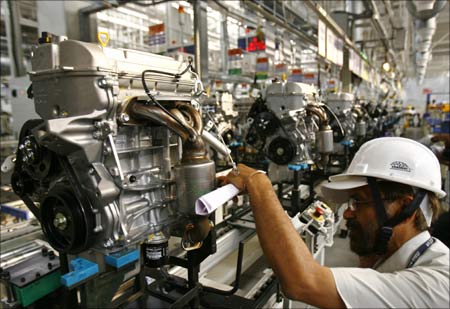
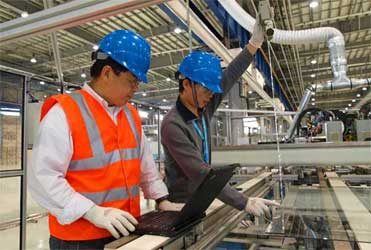
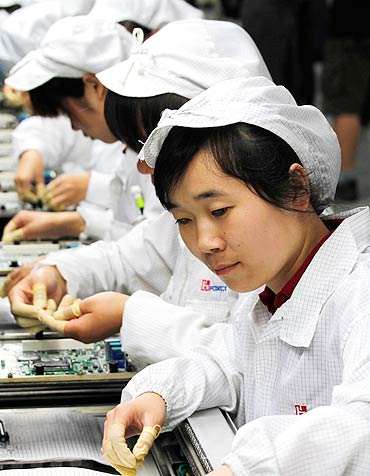


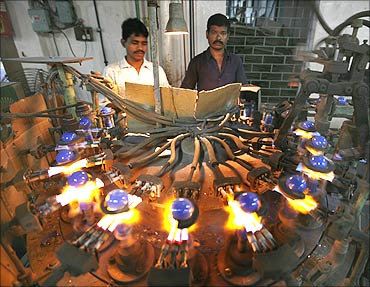
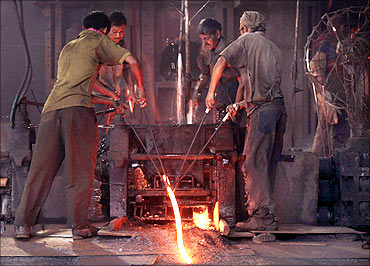
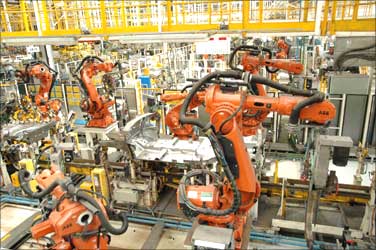
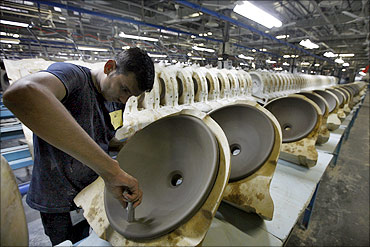

article